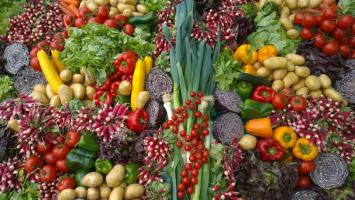
DIET & LIFESTYLE
DISCOVER HOW TO HEAL
Written by John Immel,      3 ratings, 83 likes 3 ratings, 83 likes
Customer Reviews5.00 out of 5 stars     Sign in to review this article Sign in to review this article"I love the useful details yet simple breakdown of its practical applications for day to day. Thanks." - Tressey Adams,      Ayurveda does this interpretation using a simple system known as rasya, virya, vipak, which translates to taste, potency, and post digestive effect. Using rasa, virya, vipak, Ayurveda efficiently classifies the medicinal properties of food and shows you how to do it too. Practitioners generally learn about this system in Ayurveda School and then teach it to their clients. Here are the basics. Have you ever developed really dry skin out of the blue and can't figure out why? You may ask, "Is it my diet? Have I eaten anything drying?" Using the rasa, virya, vipak classification system, you can easily identify drying foods based on your experience. With knowledge of this system, you would know how to identify astringent foods that pull moisture from your body. You would experience the astringency directly because they make your tongue feel dry. Examples of astringent foods include beans, cranberries, and potatoes. These foods might worth examining if you have dry skin, to see if they are compatible with you. It might be reasonable to assume, based on your experience, that foods which make your mouth feel dry might also make your skin dry. You can confirm this after eating such foods by noticing your poop is drier or has cracks in it. You feel the effects of Astringency first in your mouth at first, then in your digestive tract, and finally on your skin. Rasa, virya, vipak is an elegant way to connect cause and effect between diet, digestion and your body. This classification system isn't only diagnostic. It also shows you how to rebalance your system more quickly. In the example above, you might assume a food that is moisturizing and soothing like oatmeal would directly counteract dryness in the digestive tract, and in your body. In Ayurveda, the both the negative and positive effects of food are studied, contemplated, and ultimately used strategically for medicinal effect. Ayurveda breaks up your food experiences into 4 parts. Step 1: Rasa (Taste)The taste of a food is called its rasa. Rasa has several meanings, one of which is 'taste' and another is 'first impression.' If you meet someone new, or travel to a new place, you will get an initial "taste" of the person or place. The same is true with your first impression of food. This part of your food experience is easiest to determine. It's the first thing you notice when you put food into your mouth - the immediate sensations it produces on your tongue. Taste makes food enjoyable or unpleasant. Without taste, it's challenging to make good food choices.Taste is not only in the food, but also in your body's reaction to the food. Your taste buds are constantly changing. Food tastes differently depending on the time of year, imbalance you are having, and what you've eaten recently. The food cravings you have are closely related to this communication between taste buds and the blood. Taste connects food, body, blood chemistry and cravings together. If you are struggling with cravings, the science of rasa can help you. Rasa boils down to knowledge of the 6 tastes in Ayurveda - sweet, sour, salty, pungent, bitter and astringent. Each taste is made up of 2 elements and correlated with numerous experiences (gunas).
Some foods have more than one taste. Garlic is an example. It is said to contain all 6 tastes except salty. Celery is both pungent and bitter. Apples are both sweet and sour. The combination of tastes and gunas in a food create its unique effect on the body. This unique effect determines whether that food is compatible to an individual's constitution. If you don't know your constitution, you can take a test to determine it. As a nuance, rasa may also refer to the nutrients in either food or blood plasma. For example, the sweet juice of an apple is its rasa. In the blood, rasa is the proteins, fats, carbohydrates, vitamins and minerals that 'sweeten up' your blood. After you eat it, the rasa of food becomes the rasa of your blood. Once the rasa of the apple reaches your blood, it is no longer a first impression, but a lasting impression. The purpose of taste and food cravings is to build good rasa in the blood. Your taste buds, if they are functioning correctly, are supposed to sense the rasa of the food so your body will know whether it is compatible with the rasa of your blood. Taste helps the body to predict the effect that the food will have and helps you perceive what you are eating. Unfortunately, various imbalances can disturb your taste buds and prevent you from predicting the rasa of a food correctly. If your tongue has a heavy coating, is dried out, or is unhealthy food will not have the proper taste.  Artificial sweeteners can also confuse the natural intelligence of your taste buds. Your body tastes the sweetness and expects nourishment from it, but the sweetness is an illusion. The food doesn't provide the effects that the taste promised. Taste affects many areas of the body including the entire GI tract, and any part of your body that is highly sensitive to blood composition. These areas include:
Step 2: Virya (Potency)As you digest it, food has a heating or cooling effect on your entire body know as virya. Virya comes from the same base words as virile, meaning it is the "power" of the food. Food either heats up your metabolism, or cools it down, an effect you can notice if you pay attention. Virya also describes how food affects your digestive fire (agni). Does it rev up your digestion or cool it? Virya especially affects the stomach and small intestine.A heating virya serves to balance Kapha and Vata because they are cold but aggravates Pitta because Pitta is hot. A food with heating virya promotes digestion, increases body temperature, enhances blood circulation and energizes you. Cooling virya serves to balance Pitta's heat while aggravating Vata's cold nature and Kapha's sluggish nature. Foods with cooling virya slow down digestion, soothe irritation and inflammation, lower body temperature, and promote growth and weight gain. If the overall virya of your diet is too cold, it can lead to indigestion. If it's too hot, it can lead to hyperactivity and irritation by gastric juices. This cooling or heating effect of food can be easily sensed as you develop self awareness around eating. How does the food make your body feel during first two hours after eating it, particularly in terms of body temperature? Notice whether you feel warmer
Step 3: Vipak (Post-Digestive Effect)The vipak is the long-term impact of a food. Vipak describes the total post digestive effect of food on your body. It includes the medicinal effects of the food on your body that linger after digestion is complete. Vipak begins with the food's effect on your bowel elimination and your colon but continues beyond the colon. It includes the effect on your urine, feces, sweat, and mind. Vipak also describes how the tissues of your body are nourished by what you eat.Suppose you ate a lot of popcorn for days and then noticed your skin was dry. Or, you indulged in too much salt and retained water for several days after. Or, you've eaten too much oil lately and have noticed your skin is oilier than normal. These lasting after effects are attributed to vipak. Ayurveda recognizes three types of vipak: sweet, sour, and pungent. Sweet vipak is anabolic which means it promotes growth and moisture and increases Kapha. Sweet vipak encourages the elimination of urine, feces and sweat. It is helpful in situations of deficiency - common when Vata dosha is aggravated. Sweet vipak comes from sweet and salty tasting foods, generally considered building foods. Some examples include:
Pungent vipak is drying and promotes weight loss. It increases Vata and decreases the output of urine, feces, sweat and other bodily secretions. Some examples of foods with pungent vipak include:
Step 4: Prabhav (Special Effect)Finally, food has a prabhav. Prabhav is the unexplainable effect - sort of like a hidden superpower of a food. Normally, the rasa, virya, and vipak of a food are all related. The prabhav is the exception to this rule and cannot be predicted, but must be learned through experience, testimony, or research. The prabhav of each food makes it valuable for unique conditions. Prabhav can affect specific areas of the body or have a special potency, depending on its special power.For example, ghee is known to reduce fevers but there is no explanation of why it works so well at doing that. Normally, nourishing foods increase fever, hence the adage "Starve a fever, feed a cold." A person with a chronic fever cannot indefinitely starve themselves, however. This unique property of ghee makes becomes very useful for those who are debilitated by chronic fever, but need the nourishment that ghee provides. Ghee's ability to reduce fever is therefore a pleasant and very valuable surprise clinically. Cilantro is another example. It's a great digestive. However, unlike most digestives which are hot, cilantro is cooling. This cooling effect makes cilantro very useful for indigestion due to inflammation. Or, take the example of honey. While most sweeteners are cold in nature and cause weight gain, honey is heating and improves fat metabolism. This prabhav makes honey an ideal sweetener for Kapha in moderation. Mung dal, used in kitchari, has all the fiber of a legume but is uniquely easy to digest. The list goes on. Every food has numerous prabhavs, waiting to be discovered. Herbs also have a prabhav. Shatavari, for example, is a nourishing antimicrobial. Most antimicrobial herbs are depleting. This makes shatavari useful for weak or underweight individuals suffering from a gut bug. ConclusionRasa, virya, and vipak help you predict the therapeutic qualities of food, while prabhav reveals special qualities about a food or herb for unique clinical situations. But how can you use this information in a practical way?Let's consider a common scenario: Suzy has a heat condition characterized by rashes. Upon questioning we find she has an imbalance in gut bacteria and irritation of the gut. What rasa, virya, vipak, and prabhav would be useful for her? First, she'll need foods with a cooling virya to calm the hot rash and irritation in her gut. Foods with sweet, bitter and astringent rasa are known for their cooling properties. Potatoes are both sweet and astringent, ideal for cooling. Kale is a suitable bitter. Overgrowth of bacteria in the gut is a sign of weak digestion. Therefore, the client will also need a digestive. Cilantro is the perfect choice because it has a cooling prabhav. Ayurveda suggests that a potato & kale soup garnished with cilantro would be ideal for this client. This is just one example of how Ayurveda uses rasa, virya, vipak and prabhav. Its simple elegance yet profound depth makes these principles a cornerstone of your Ayurvedic education and Ayurveda's clinical approach in general, used daily by practitioners and clients alike. READ MORE ON THIS TOPIC
BROWSE SIMILAR ARTICLES BY TOPIC

About the Author John Immel, the founder of Joyful Belly, teaches people how to have a healthy diet and lifestyle with Ayurveda biocharacteristics. His approach to Ayurveda is clinical, yet exudes an ease which many find enjoyable and insightful. John also directs Joyful Belly's School of Ayurveda, offering professional clinical training in Ayurveda for over 15 years.John's interest in Ayurveda and specialization in digestive tract pathology was inspired by a complex digestive disorder acquired from years of international travel, as well as public service work in South Asia. John's commitment to the detailed study of digestive disorders reflects his zeal to get down to the roots of the problem. His hope and belief in the capacity of each & every client to improve their quality of life is nothing short of a personal passion. John's creativity in the kitchen and delight in cooking for others comes from his family oriented upbringing. In addition to his certification in Ayurveda, John holds a bachelor's degree in mathematics from Harvard University. John enjoys sharing Ayurveda within the context of his Catholic roots, and finds Ayurveda gives him an opportunity to participate in the healing mission of the Church. Jesus expressed God's love by feeding and healing the sick. That kindness is the fundamental ministry of Ayurveda as well. Outside of work, John enjoys spending time with his wife and 7 kids, and pursuing his love of theology, philosophy, and language. STUDY AYURVEDA
Questions, Comments & Impressions of 'how to understand food like an ayurvedic counselor: rasa, virya & vipak'?Is there something else you'd like to know about 'how to understand food like an ayurvedic counselor: rasa, virya & vipak'?     (5.00 out of 5 stars) 3 ratings, 83 likes (5.00 out of 5 stars) 3 ratings, 83 likes     Sign in to review this article Sign in to review this article
I love the useful details yet simple breakdown of its practical applications for day to day. Thanks.
|
Join Joyful Belly.
Want our top Ayurvedic recipes and health tips?Subscribe to our free newsletter!

 SAVE ARTICLE
SAVE ARTICLE

 On MeWe
On MeWe On Pinterest
On Pinterest On Facebook
On Facebook On Twitter
On Twitter On WhatsApp
On WhatsApp On Email
On Email


